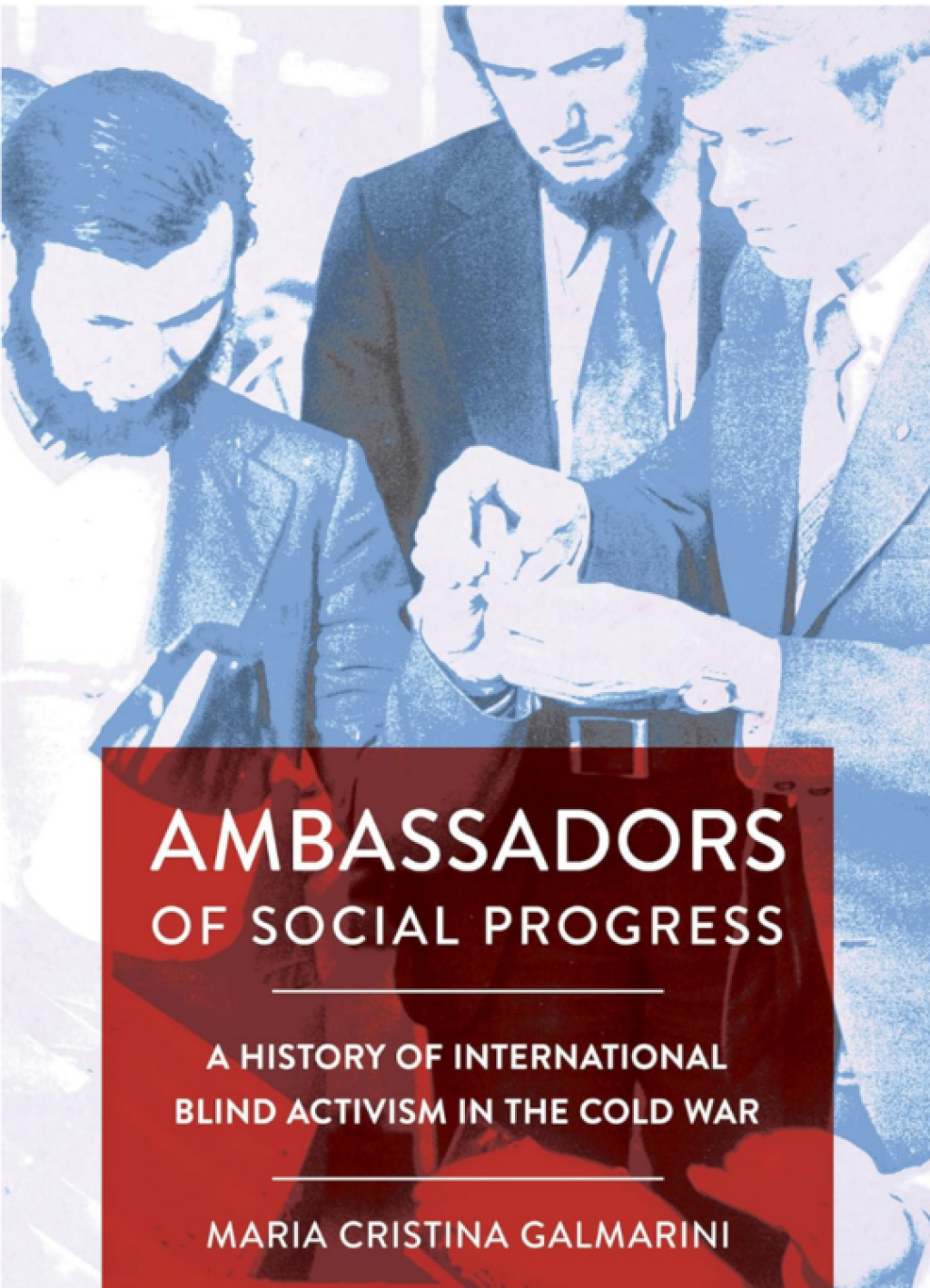This is Part II in a two-part series. Part I ran on 4/2 and may be seen here.
Maria Cristina Galmarini is Associate Professor in History and Global Studies at the College of William and Mary. Some material in this post is drawn from “Socialist Blind Activists, the International Disability Movement, and the Forgotten Legacies of the Cold War,” the introduction to Ambassadors of Social Progress: A History of International Blind Activism in the Cold War, a Northern Illinois University Press book published by Cornell University Press. Copyright (c) 2023 by Cornell University. Used by permission of the publisher.
While the socialist governments of the Soviet Union and Eastern Europe embraced the disabled as weapons of Cold War cultural diplomacy and activists used the occasion to give visibility to their constituencies, not all disabled citizens were made visible. In fact, many of them—and especially their problems—were frequently erased. As disability scholar Rosemarie Garland-Thomson has discussed, societies’ politics of disability representation are informed by the models they adopt to conceptualize disability, with imagery of disabled people usually enlisted for specific purposes. In order to understand the apparent paradox of the socialist politics of (in)visibility we need to abandon standard, Western-driven scholarly distinctions between a medical and a social model of disability, rather admitting the historical legitimacy of a third, “socialist” paradigm. It is from the perspective of this distinct approach the we should address the question of who was displayed in socialist disability advocacy and what marginalizing effects the denial of representation had on all others.
Disability scholars identify a medical model which views disability as a problem that can and should be prevented or fixed. This model places emphasis on what is wrong with the disabled person, looks at the ways in which he/she deviates from the norm, and tries to narrow that gap by enhancing the problem-citizen’s ability to perform. The assumption informing this paradigm is that ‘normal’ is automatically desirable.
Interactions between activists, people with disabilities, and the state under socialism were certainly governed by a medical model of disability, especially since the knowledge on which disability activism was based came precisely from medical and defectological ideas of normalcy.
Unlike its medical counterpart, however, the socialist model rejected emphasis on charity and the view that disabled people need to be pitied. Charity and pity came from older religious approaches, which the Western medical model had secularized and integrated in its corrective philosophy. As opposed to them, the socialist model underscored that any disabled person can overcome disability and become an ideal socialist subject through the acquisition of labor skills. Furthermore, while medical and welfare professionals exerted a fair amount of control over the lives of disabled people in socialist countries, deaf and blind organizations were mostly staffed and led by people with disabilities. As such, they stressed capabilities and campaigned for their constituencies’ right to participate fully in society.
Scholars in disability studies also speak of a social model of disability, which politicizes disability by defining it as the result of social and environmental disablement. Like it, the socialist paradigm, too, focused on political responses to disability, but with a specific ideological twist. While it considered “invalidity” (the state of being unemployed and forced to beg for charity) as a product of bourgeois power relations, it could not possibly see disability as a form of social oppression within its own society because this would have meant openly criticizing socialism. This resulted in what Ned Richardson-Little called “a politically useful double-standard,” which allowed authorities to hide domestic abuses while simultaneously criticizing capitalism’s shortcomings.
In addition, the socialist model of disability aspired to fight disabled people’s isolation. The systems of sheltered employment and segregated education that characterized socialist disability policies were not supposed to remove the invalids from society, but rather to prepare them toward the purported—but indefinitely delayed—goal of integration.
In this model, impaired bodies were denied representation in their everyday realities and instead “bestowed meanings” that symbolically produced and re-produced socialism. One of these “meanings” was that charity had no place in socialist societies because the state took full care of its most vulnerable citizens and included them in productive labor. Accordingly, pitiful and helpless “invalids” could not possibly be a visual component of the socialist world. Another “meaning” pertained to public health services, which in the socialist countries were said to have reduced and even completely eliminated disabling disease. Especially congenital blindness—which activists both East and West tended to associate with poverty, lack of hygiene, and backwardness—was, as Boris Zimin has written, declared “a rare occurrence” in the Soviet Union, while most new cases of loss of sight came from unfortunate life accidents or the “natural” process of ageing. The official line on the socialist resolution of the problem of congenital blindness explains why, in a 2019 conversation with the Italian blind activist Rodolfo Cattani, one VOS member declared, “we don’t have blind children.” Children born blind called into question socialism’s achievements in health, hygiene, and maternal care. Hence, they were kept largely invisible since the Stalinist 1930s and throughout the postwar period.
Furthermore, as the socialist state’s investment varied from one form of impairment to the other, so did the visibility of different disability groups (even within the broad category of physical disabilities that I am considering here). As Valery Fefelov has written, when the organizers of the Stoke Mandeville Games invited the Soviet Union to participate in this competition, a Soviet official responded: “there are no invalids in the USSR.” This statement was an (awkward) effort to preserve an image of social progress in the perception of foreign audiences. Indeed, blind sportsmen who won medals at international events could provide a “spectacle” for the story of rehabilitation that was essential to Soviet approaches to disability; their athletic activities, which required less infrastructural improvements to flourish than those of other disability groups, could be utilized to celebrate and legitimize the order of socialism. But helpless invalidy on heavy wheelchairs and inadequate prostheses would have told a different story. They would have revealed the Soviet Union’s unequal distribution of resources in a biased architectural environment. Appearing next to Western Paralympic champions, they would also have undermined the official discourse of a state that attributed “invalidity” only to the capitalist world and claimed for itself the capacity to turn all disabled people into happily integrated individuals, successfully reforged, restored, and transformed.
Destigmatizing and giving visibility were among the most important goals of socialist blind organizations. These associations’ sightless leaders participated in diplomatic work as visibly disabled persons, ironically being the most visible representatives of their countries’ disabled. They wore black glasses, carried white canes, and let their assistants guide their hands to shake those of political authorities. By doing so, they chipped away at disability stigmas and dismantled the assumption that blindness precludes accomplishment. Audiences recognized them as being blind, while also discerning their dignity and the geopolitical importance of their work. These intersecting aesthetics of disability and diplomacy, I argue, provided socialist activists with a potentially very powerful means to contest perceptions of blind people as irrelevant non-workers, rather presenting them as central assets to the projects of their governments.
However, the strategies that socialist activists employed to achieve visibility for their constituency also confirmed the ableist position of their states. First, visibility was achieved almost exclusively in non-mainstream events and spaces. Lay publics were rarely involved, and the blind were made visible only to the governing elites who either dignified these events with their presence or read reports about them. Second, in their international encounters as well as on the pages of their journals, socialist blind activists displayed only the successful blind who had become “able disabled” and “supercrips” (in Sharon L. Snyder’s and David T. Mitchell’s terms)—while simultaneously losing any right to fail and be different. These included champion chess players, athletes, scientists, and heroes of industrial labor, but not the many ordinary blind who struggled with access and social integration in their everyday lives.
Thus, socialist blind activists supported a visual economy that required most disabled people to be out of sight to give visibility to those few whose healing and rehabilitation confirmed the correctness of the socialist approach. Socialism had overcome invalidity—or so it declared—and those blind people who overcame it too became the best ambassadors of its social progress. The others, instead, experienced political erasure and social segregation.



